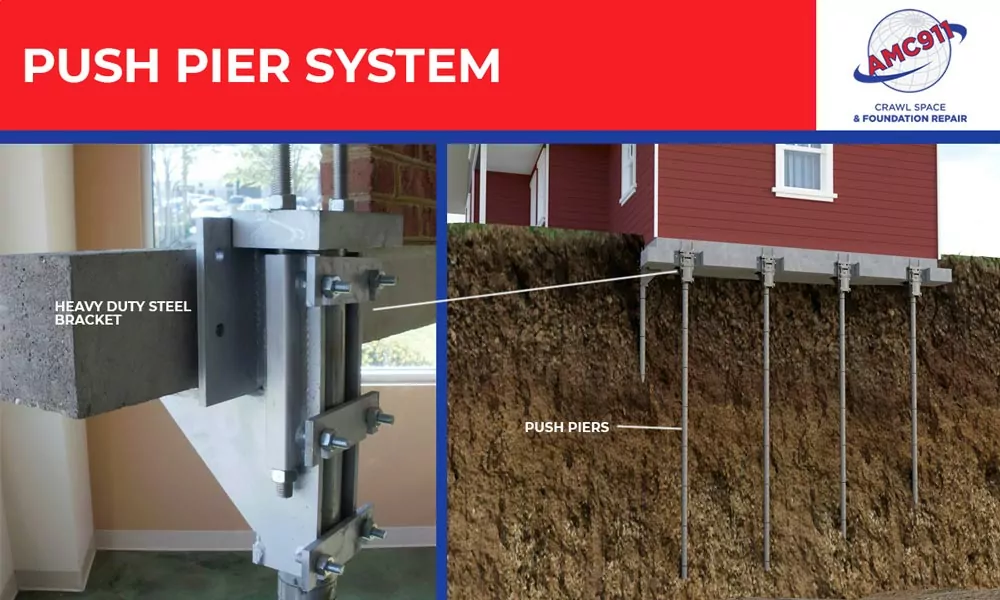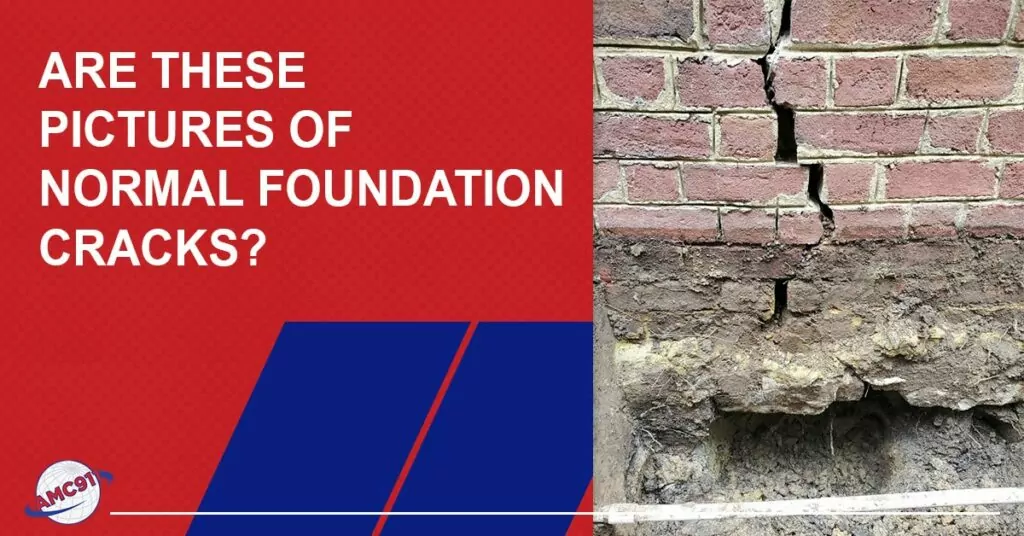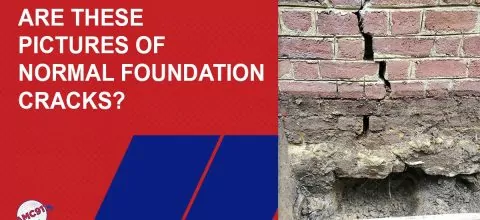As a homeowner, it’s natural for you to be concerned when you notice cracks in your foundation. While general wear and tear over time is normal, certain cracks can indicate that your home has a severe foundation problem. With this in mind, it’s essential to recognize which cracks can indicate an issue with the foundation and which may be harmless. In this blog post, we’ll help you learn how to tell the difference between non-structural foundation cracks and something more serious, so that you can be better equipped to take the steps needed to protect your home.
Non-structural vs. Structural Foundation Cracks
Knowing the difference between non-structural and structural foundation cracks is a vital part of maintaining the safety of your home and avoiding costly repairs.

What Is a Non-Structural Foundation Crack?
A non-structural foundation crack is a crack which appears in the foundation of a building or structure that does not endanger the overall stability of the foundation.
What Causes Non-structural Foundation Cracks?
Usually, non-structural foundation cracks in a poured concrete foundation wall are the result of shrinkage that takes place during the concrete curing process. Concrete is a complex mixture of cement, water, and various aggregates. As the concrete cures, the water evaporates and the material shrinks. This shrinking can cause cracks to occur in a poured concrete foundation wall.
While a shrinkage crack in a foundation wall isn’t a structural issue, it can allow moisture to seep through the wall and into your basement or crawl space. Filling a shrinkage crack with an appropriate sealant or injection can help prevent moisture and pests from penetrating the foundation and causing further damage.
What Do Non-structural Cracks Look Like?
Non-structural foundation cracks caused by shrinkage are typically vertical and less than 1/10 inch in width. Unlike structural cracks, which can pose a serious risk to the stability of a building, non-structural cracks don’t tend to widen or grow over time. That being said, they can still be unsightly, and potentially lead to moisture infiltration or bug infestation if left untreated.
What Is a Structural Foundation Crack?
A structural crack indicates that a foundation problem has compromised the entire structure. Therefore, it is essential to have a professional foundation repair contractor inspect any cracks in the foundation to determine the cause and severity of the damage.
What Causes Structural Foundation Cracks?
Various factors–including differential foundation settlement, poor construction, inadequate drainage, and natural disasters like earthquakes–can cause structural cracks.
What Do Structural Cracks Look Like?
Typically, structural foundation cracks are wider than 1/10 inch (often much wider). They can take on a variety of shapes, including horizontal, diagonal, or stair step. In some cases, the cracks may be very subtle, while in others, they may stand out prominently.
One key characteristic of structural foundation cracks is that they get bigger over time. This is because they indicate instability in the foundation, which can lead to further damage if it is not addressed promptly. As the cracks widen, they can allow moisture, insects, and other unwanted elements into the home, making the problem even worse.
If you notice any cracks in your foundation, it is important to take action right away. A professional foundation repair contractor can help assess the situation and recommend the appropriate course of action.
Repairing Structural and Non-structural Cracks
Common Repair Options for Structural Foundation Cracks
Wall Plate Anchors
Wall plate anchors are installed to provide lateral support to the wall and prevent further movement.
Carbon Fiber Straps
Another solution is the use of carbon fiber straps. These straps are installed on the damaged wall, reinforcing it and preventing further cracking. Carbon fiber is known for its high tensile strength and durability, making it an excellent material for strengthening cracked walls.

Push Piers
If the foundation crack was caused by differential settlement, then using push piers is a common repair solution. Push piers are hydraulic cylinders that are installed under the foundation of the building. They work by stabilizing the foundation and preventing further movement.

In addition to these repair solutions, it’s essential to address the root cause of the cracks to prevent further damage.
Common Repair Options for Non-structural Cracks
While non-structural cracks in a foundation wall do not pose an immediate threat to the structural integrity of the building, they should still be sealed because they can cause aesthetic problems, reduce the durability of the concrete, and lead to water leakage or other forms of moisture intrusion.
The most common repair solution is epoxy injection. This technique involves injecting a low-viscosity epoxy resin into the cracks under pressure, which fills the voids and creates a bond between the two sides of the crack. The epoxy then hardens and restores the concrete’s overall strength.
Should I Worry About Normal Foundation Cracks (Non-structural)?
Non-structural cracks in your home’s foundation should not cause you undue worry. However, it’s crucial to take the necessary precautions to prevent any further damage from occurring to your home’s structure. By sealing these cracks, you can help protect your home and ensure that it remains a safe and comfortable place for you and your family.
Cost to Fix Normal (Non-structural) Foundation Cracks
The cost to fix non-structural (i.e., normal) foundation cracks will depend on various factors, including your geographical location, ease of access, and the materials used. Non-structural cracks almost always cost less to repair than structural foundation cracks.
Will My Homeowner’s Insurance Cover the Cost of Fixing a Non-structural Foundation Crack?
Standard homeowner’s insurance policies typically do not cover the cost of non-structural (i.e., normal) foundation cracks. Homeowners should review their policy and speak with their agent to build a better understanding of what is and isn’t covered. Preventative measures are the best way to minimize the risk of foundation cracks and mitigate the financial burden of repairs.
Can I Fix a Normal Foundation Crack (Non-structural) Myself?
While it is possible to repair non-structural foundation cracks on your own, it is always best to have a professional assess the situation first. This way, they can determine the cause of the crack and recommend the appropriate course of action. If the crack is non-structural and minor, they can also provide guidance on how to repair it yourself.
Tips on How to Prevent Foundation Cracks
Fortunately, there are several preventative measures that homeowners can take to help avoid foundation cracks, including:

- Regrade the yard – One of the most effective ways to prevent foundation problems is by regrading the yard. Regrading involves reshaping the ground around the foundation so that it slopes away from the house, ensuring that water flows away from the foundation instead of towards it. This helps prevent soil erosion and water buildup (two common causes of foundation damage).
- Clean gutters regularly – When gutters are clogged with debris, water can overflow and pool around the foundation, causing damage over time. Regular cleaning ensures that water flows freely through the gutters and away from the foundation.
- Install downspout extensions – Downspout extensions redirect water from the downspouts away from the foundation before release. This can be especially important if the house is located on a slope or there is heavy rainfall in the area.
- Install a drain tile system – A drain tile system is designed to collect and redirect groundwater away from the foundation.
- Keep trees with extensive root systems away from the foundation – Some trees have root systems as wide as their canopies that can invade the ground under the foundation. They then “drink” water from the soil, causing it to dry out and shrink, leading to foundation settling.
Note that most of the above measures involve controlling groundwater around the foundation, since most foundation problems–including cracks–are caused by excess moisture in the soil. By taking these preventative measures, homeowners can help ensure the long-term health and safety of their foundation, avoiding costly repairs and preserving their home’s value and structural integrity.
If you’re concerned about one or more foundation cracks in your Hampton Roads home, contact AMC911 today to schedule a free inspection and receive a repair estimate.















